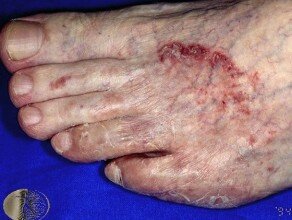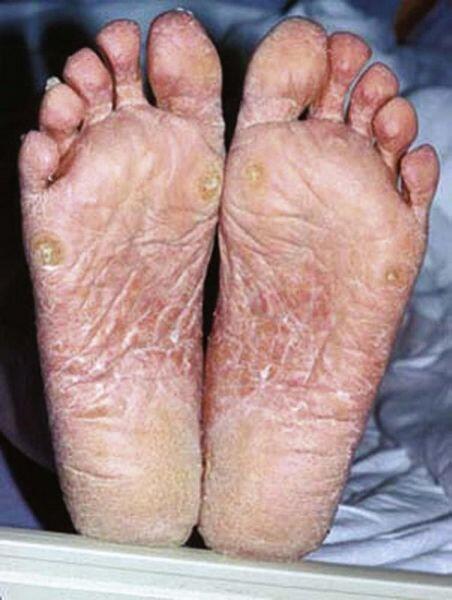Definition of Tinea Pedis
The term tinea pedis is used to refer to dermatophyte infections of the feet. These infections often involve the interdigital spaces, but chronic diffuse desquamation can affect the entire sole.

Geographical distribution of Tinea Pedis
The condition is worldwide in distribution.
Causal organisms
The anthropophilic dermatophytes E. floccosum, T. mentagrophytes var. interdigitale and T. rubrutn are the commonest causes of tinea pedis in the UK and North America. T. rubrutn is the principal cause of chronic tinea pedis. T. mentagrophytes usually causes more inflammatory lesions.
Tinea pedis is a very widespread condition that appears to be increasing in prevalence. It often begins in late childhood or young adult life and is most common between the ages of 20 and 50. Men are more frequently affected than women.
The infection is usually acquired by walking barefoot on contaminated floors. Hyphae and arthrospores of the causal dermatophytes can survive for long periods (> 12 months) in human skin scales. Excessive sweating and occlusive footwear are factors that favour the development of tinea pedis.
Management of Tinea Pedis
Tinea pedis will often respond to topical treatment with an imidazole compound, such as clotrimazole, econazole, miconazole or sulconazole, or an allylamine, such as naftifine or terbinafine. Terbinafine should be applied to the toe clefts and other affected sites morning and evening for at least 2 weeks. Imidazoles often need to be applied for up to 4 weeks. The patient may also benefit by applying the cream to the soles to help prevent the infection from spreading. The recurrence rate following topical treatment is quite high, and chronic infection with minor scaling that persists despite treatment is not uncommon. Exacerbations of previous infection may also occur.
Mixed fungal and bacterial infections of the feet are common. For this reason, topical antifungal preparations that are effective against dermatophytosis and candidosis, and which possess some antibacterial action (such as miconazole) are often recommended.
If the disease is extensive, involving the sole and dorsum of the foot, or there is acute inflammation, oral treatment with terbinafine (250 mg/day for 2-6 weeks) or itraconazole (100 mg/day for 4 weeks) should be given in addition to topical treatment (which should be continued for 8 weeks or longer). However, relapse is common.
Chronic tinea pedis is often associated with nail infection. Inadequate treatment of onychomycosis may result in reinfection of the feet.
Tinea pedis is a chronic condition which seldom resolves if left untreated. Exacerbations, which tend to occur in the summer, alternate with partial remissions. Nevertheless, the prognosis in general remains benign.

It is important to inform the patient of measures that may help to control or prevent the infection. Daily bathing of the feet, followed by careful drying of the toes and interdigital spaces, is important. The patient should also be advised to avoid heavy occlusive footwear, which may increase sweating, and to wear soft absorbent socks.
Once the clinical symptoms have cleared, use of an anti-fungal foot powder on the feet and inside footwear may prevent reinfection.




